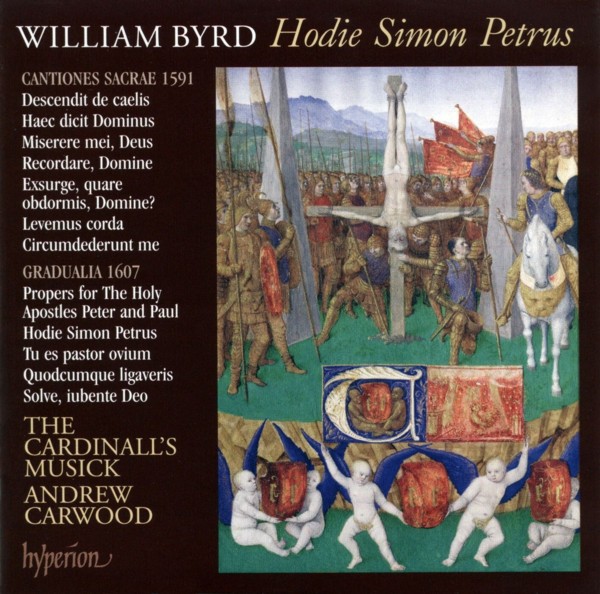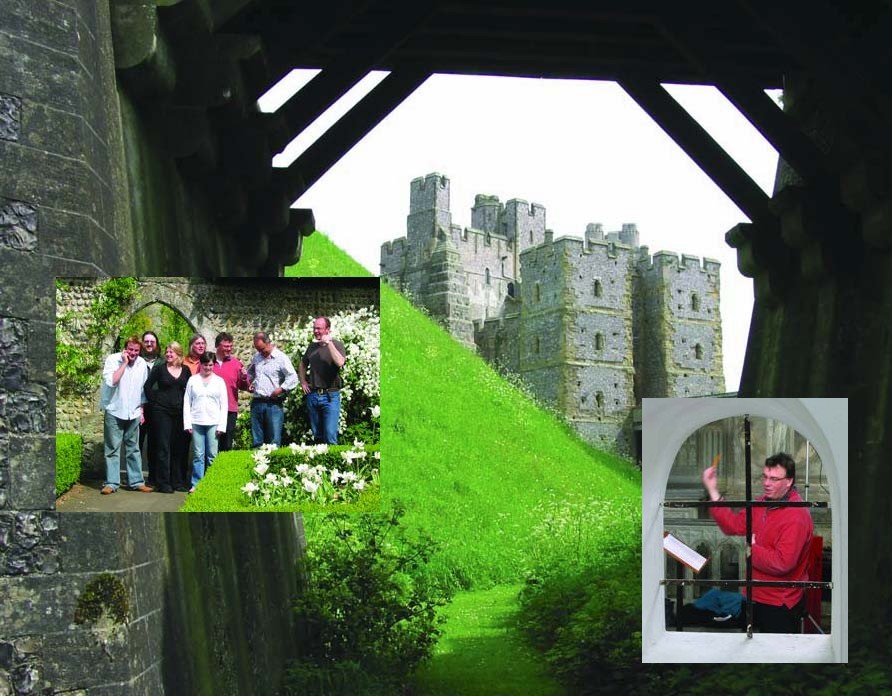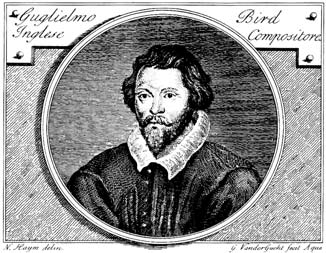William BYRD. Hodie Simon Petrus
Byrd Edition vol.11 / The Cardinall's Musick

hyperion
hyperion CDA67653
febrero de 2009
grabado en noviembre de 2007
Fitzalan Chapel, Arundel Castle, UK
William Byrd
(1539/40-1623)
The Cardinall's
Musick Byrd Edition Vol.11
Hodie Simon Petrus
Cantiones Sacrae 1591
Gradualia 1607
01 - Descendit de
caelis [5:34]
02 - Tu es pastor ovium [2:03]
03 - Miserere mei, Deus [3:05]
04 - Circumdederunt me [4:50]
05 - Quodcumque ligaveris [4:16]
06 - Recordare, Domine [6:05]
07 - Exsurge, quare obdormis, Domine? [4:18]
08 - Laetania [8:57]
09 - Nunc ccio vere [5:23]
10 - Constitues eos principes [3:08]
11 - Tu es Petrus [2:13]
12 - Levemus corda [4:45]
13 - Hodie Simon Petrus [3:53]
14 - Solve, iubente Deo [2:40]
15 - Haec dicit Dominus [6:44]
#1: SAATTB
#2, 5: AATTBB
#3: SATBarB
#4, 15: ATTBarB
#6, 7, 12: AATTBB
#8: BarˇATTB
#9, 10, 11, 13, 14: AATTBarB
THE CARDINALL’S MUSICK
Andrew Carod
soprano: Carys Lane, Rebecca Outram
alto: Patrick Craig, David Gould, Caroline Trevor
tenor: Steven Harrold, Julian Stocker
baritone: Robert Evans
bass: Edward Grint, Robert Macdonald

FUNDAMENTAL CHANGE in the Church is
rarely easy to achieve with unanimity and without pain and division.
The people of early sixteenth-century England had only ever known one
belief system, a complicated set of rules preserved and developed by a
Church with its spiritual head in Rome. It governed their daily lives
and although the conjoining of Church and State led sometimes to storms
and tempests and division, it was ultimately secure. The Reformation
destroyed certainty and left people only with questions. The English
owed allegiance to their monarch and to their country but the spiritual
focus of their lives, that which dealt with their immortal soul, was
the Roman Church. Who had the right to tell the people what do? The
King of England or the Bishop of Rome?
Musicians were not exempt from these weighty matters and in the early
days they were all forced to react. John Merbecke, the Windsor-based
composer, decided that his extended Latin votive antiphons were now
useless, threw them to one side and embraced reform. Nicholas Ludford,
the prolific composer and churchwarden of St Margaret’s,
Westminster, also seems to have stopped composing his Latin works, but
not because of any desire for change, rather because of a deep
dissatisfaction with the way in which religious policy was unfolding.
Time is a great healer however and, as the century progressed, people
forgot the old ways. Those who had grown up under Elizabeth’s
intelligent and sensible settlement took the reformed Church as a
given. Composers such as Thomas Weelkes, Orlando Gibbons and Thomas
Tomkins found themselves part of a uniquely English institution which
allowed them the freedom to produce exceptional music. Yet, for those
who still held their allegiance to Rome these days were hard, full of
persecution and deprivation. William Byrd had grown up not with the
reforms of Elizabeth but with the Catholic restoration of Mary. Born in
1539 or 1540, he was probably a chorister in London and was a teenager
during the politically and artistically stimulating early years after
Mary’s accession. It must have been at this time that a desire
for England to remain Catholic became embedded in his heart.
As a devout Catholic and a brilliant musician it is perhaps a little
strange that Byrd should never have travelled abroad. All eyes looked
to Italy for art, manners and etiquette and many left England either to
experience the various styles and fashions of the Continent or to flee
the Catholic persecution. Much of Byrd’s life however was spent
in London (apart from a brief spell as the young organist of Lincoln
Cathedral) until he moved to a quieter life in the countryside of Essex
in the 1590s. He was truly an English composer and perhaps it is
possible to see in this move, this nesting in the countryside, an even
more definite statement of his beliefs. His writing is unmistakably
English and it is likely that his view of Catholicism was also deeply
English: these two elements are clearly brought together in his music.

With the exception of the Litany, the pieces contained on this disc,
the eleventh devoted to the Latin Church music of Byrd, are from two
sources: the Cantiones Sacrae of 1591 (published at the end of
his time in London) and the second book of motets entitled Gradualia
from 1607 (which contains music probably written for the Catholic
community based around Ingatestone Hall in Essex). The seven motets
from 1591 show Byrd to be preoccupied with thoughts of desolation,
loss, deprivation and separation—thoughts which were obsessions
for the recusant Catholic community. Yet it is rare for Byrd not to
offer salvation in his music, indeed this is his constant refrain. Each
piece provides at least a glimmer of hope and often contains an
outright statement of positive thought.
If ever a piece was designed to speak directly to the Catholic
community, it is the five-voice Haec dicit Dominus. The text
speaks of the Old Testament character Rachel, whose sons have been
murdered—a telling choice of subject for those who were
witnessing the execution of their supporters and priests. Rachel is
bereft and destitute and she refuses all comfort. But the answer from
the Lord is positive and forward looking—‘et est
spes’—‘and there is hope’. The Latin words are
incredibly direct and simple, and so powerful and unexpected is this
statement that the music almost stops. These are exactly the words that
the people needed to hear and Byrd makes sure they are as clear as if
an angel of the Lord had appeared and spoken.
Descendit de caelis has a ravishing texture. Byrd proudly
displays his English heritage by setting a pre-Reformation Sarum rite
text involving a cantus firmus (a favourite device of John Sheppard and
his contemporaries) complete with dissonances and false relations. Yet
as so often with Byrd there is a nod in the direction of modern ideas,
at the words ‘lux et decus’ (‘the light and
glory’) he uses a hopeful, upward-rising phrase which he was to
develop further in the set of Propers for the Feast of Candlemas
(recorded on Volume 8 of this series), which celebrates Christ as the
light of the world.
Thanks to the efforts of editors in the twentieth century some of
Byrd’s works have become well established gems of the repertory.
One such is the five-part Miserere mei, Deus. A clear
homophonic opening asking for mercy moves quickly into beautiful
imitation. The text contains several words which seem to elicit
particularly powerful melodies from Byrd, especially
‘iniquitatem’ (‘wrongdoing’) and
‘misericordiam’ (‘mercy’); indeed the melody of
this latter word was one that he was to take forward and use in the
monumental Infelix ego.
Circumdederunt me shows Byrd in a more mournful light but also
in a more contemporary one. He employs a number of telling harmonic
shifts which he must have learned from his Continental colleagues and
developed in his younger years. The piece moves upwards in tessitura
and intensity at the repeated words ‘O Domine, libera animam
meam’ (‘O Lord, free my soul’) before subsiding as if
exhausted. Similar in feel is Recordare, Domine, a piece asking
for God to recall his promises to mankind and not to destroy the earth.
Fear and awe dominate in the first half of this piece but some warmth
enters later at the mention of the ‘holy city’ before Byrd
returns to his opening plea for mercy for the world. There is a more
positive approach in Levemus corda with its faster harmonic
pulse and flexible melodic lines, but the subject matter is still the
same. Exsurge, quare obdormis, Domine?, by contrast, is one of
the most energized pieces in the 1591 Cantiones Sacrae. Byrd
uses a taut, sinewy melody as he demands that God should arise, not
once but three times.
In the Gradualia volumes of 1605 and 1607, Byrd produced music
for many of the Feasts of the Church’s calendar. One of the most
complex sets is the six-voiced group of motets in honour of St
Peter and St Paul (presented here together with a Litany in honour
of the saints). It may seem strange that the two most significant
saints of the Church should have to share one Feast Day but in this
sharing there is a powerful statement. The combination underlines the
power of the Church itself, built on the rock of Peter and on the
teachings of Paul. Byrd responds with music that it is cerebral,
complex, witty and powerfully rhythmic. Indeed the set contains one of
the most remarkable pieces of writing that Byrd ever produced. At the
words ‘dicit Dominus Simoni Petro’ (‘says the Lord to
Simon Peter’) in Quodcumque ligaveris Byrd indulges in a
fascinating explosion of fast notes which require considerable vocal
dexterity in terms of technique and tessitura. It is perhaps his way of
highlighting that Peter’s authority (and thus the authority of
all Bishops of Rome) came directly from Christ himself.
Unusually Byrd has varied the scoring in this set of pieces. Two of
them (Tu es pastor ovium and Quodcumque ligaveris) are
scored for a divided low bass part whereas the others are for the more
usual AATTBarB combination. This strongly suggests that they were
written at different times rather than all composed for one occasion
(perhaps Byrd was even writing for the singers whom he knew would be
present). The angst of the 1591 pieces is banished in these settings
where Byrd gives his imagination free rein. Perhaps he felt more
comfortable in Essex away from London; perhaps he was feeling the wind
of change blowing through the country as Elizabeth gave way to James VI
of Scotland who had promised (but was never to deliver) greater
toleration for Catholics. We will probably never know, but the
remarkable fact is that Byrd even in his later years could produce the
most modern-sounding and the most energetic music that he had ever
written.
He provides only three pieces (Nunc scio vere, Constitues eos
principes, and Tu es Petrus) for Mass itself. There is no
Communion setting which is certainly unusual and he relies on the fact
that the Alleluia verse Tu es Petrus has the same text as the
Offertory and that the same music could be used twice (a common
occurrence throughout the two books of Gradualia). The set is
completed by the short Solve, iubente Deo and the beautiful Hodie
Simon Petrus which, appropriately enough in a collection of texts
which otherwise refer only to St Peter, reserves its most telling music
for the mention of the death of St Paul.
On this disc it seemed appropriate to include a Laetania
(Litany) in honour of all the saints. This is beautiful yet entirely
functional music, a world away from the high art form of the other Gradualia
pieces. Yet at the words of the Agnus Dei (Lamb of God) Byrd cannot
resist writing music with a more impassioned nature. Not surprising
from a man for whom texts, their context and subtext, were clearly
everything.
ANDREW CARWOOD © 2009




